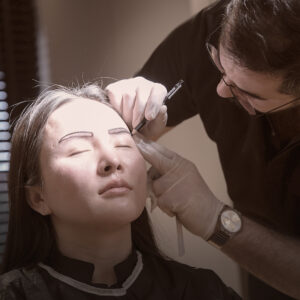Eyebrow Transplant

Eyebrows, which add meaning to the expression by clarifying the facial features, help us to convey our feelings and thoughts without the need for words. With this aspect, the main function of the eyebrow, which is considered extremely important in terms of communication, is to protect our eyes from external factors such as sweat, dirt and dust. On the other hand, the fact that it is located in one of the most striking parts of the face ensures that the eyebrow has an important place in terms of aesthetic appearance.
Eyebrow Transplantation Treatment
In the eyebrow transplant process, the most ideal treatment plan is created by evaluating the existing eyebrow and facial structure of the person. By transferring the person’s own hair follicles to the empty spots in the eyebrow area, a natural appearance and permanent thickening are obtained which is suitable for the age, width of the forehead, and the frame of the face.
How Eyebrow Transplantation is Applied
During eyebrow transplantation, the FUE method, which is frequently preferred in the field of hair transplantation, is used today. The correct determination of the eyebrow line of the person in eyebrow transplantation makes the eyebrows that will grow later look more natural. At this point, the expertise of the practicing doctor comes to the fore.
In order to remove the roots to be used during eyebrow transplantation, a small area in the nape area is sterilized by shaving in a way that is not visible from the outside. Afterwards, the person is administered a combination of analgesic (painkiller) and sedative (relaxing) drugs by the anesthesiologist. The drug shows its effect quickly and the person relaxes and goes into a state of semi-sleep like a nap. Thus, the stress of the eyebrow transplant process is not experienced and the local anesthesia process is completed without any pain. Half-drowsiness takes about 10 minutes.
Healthy hair follicles are collected from the shaved area with the FUE method. Then, the area to be transplanted is sterilized and anesthetized with local anesthesia. With the pen-shaped sapphire ore, very small, smooth micro-channels are opened in the area to be planted in a predetermined number and according to the natural direction of hair growth. Thanks to the very small opening of the channels with the Sapphire FUE method, tissue deformation can be minimized. Thus, a very natural appearance is obtained after the application. The collected roots are planted one by one in the targeted area, in accordance with the natural direction of the eyebrows. The careful completion of the application is of great importance for the success of the results obtained.
Post-Treatment and Results
Eyebrow transplantation, or eyebrow lift surgery, which is a one-day procedure, is completed in 3-4 hours in a clinical setting. Thanks to the application that does not require hospitalization, eyebrows can be filled, lengthened, or thickened. The people who have an eyebrow transplant can return to their normal life on the same day. Slight redness and swelling in the eyebrows disappear in a few days without any intervention. The slight crusting that may occur after eyebrow transplantation. Eyebrow transplantation performed with the Sapphire FUE method, known worldwide for its successful results, is completed in the blink of an eye, thanks to methods that increase patient comfort such as sedation.
When Do Eyebrows Get Fuller?
In the process following the eyebrow transplantation, the eyebrows are first crusted and shed. After this phase, which lasts between 15 days and 3 months, new eyebrows become suitable for the targeted fullness. Within 7-8 months, the newly planted eyebrows combine with the pre-existing ones and gain a healthy, voluminous and aesthetic appearance.
Post-Transplant Care
The people who have eyebrow transplants can easily turn to their normal life but it is necessary to take a break from the pool, sea, and solarium only for the first two weeks, avoid direct exposure to sunlight as much as possible, and avoid heavy sports that can force the body.
Suitable Candidates for Eyebrow Transplantation
According to legal practices, anyone who is over the age of 18 and does not have any health problems that may interfere with the procedure can have eyebrow transplantation. Therefore, we can conduct eyebrow transplants for both men and women. On the other hand, pregnant and lactating mothers and patients who are on medication may need to postpone this procedure for a while.
If you are interested in undergoing an eyebrow transplant for men or women, you may be interested in the cost of this procedure. For specific eyebrow transplant costs please use our contact form for a free consultation! The eyebrow transplant costs will be transparently outlined for you.















